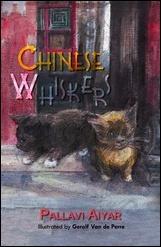|
by Karen Ma
 
Chinese Whiskers, published this January by Harper, is the second book of Pallavi Aiyar, a former Beijing correspondent for the Indian paper the Hindu. The 218-page fable follows the perspectives of two cuddly cats named Tofu and Soyabean, giving readers a fast romp through Beijing's hutongs, or courtyard neighborhoods, against the backdrop of the SARS epidemic and China's pre-Olympic construction craze. This follows her successful first book, Smoke and Mirrors, which chronicles her nearly seven years' experience in China viewed through her unique Indian lens. Targeted perhaps more at Indian cat lovers than close China watchers, the well-paced, heart-warming tale highlights the conflict between modern China and tradition. Aiyar is now stationed in Brussels and writes for Business Standard. Recently, through emails, as well as a visit at her Nizamuddin East home during one of her regular visits to Delhi, I asked her some of the hows and whys behind this interesting new book. Karen Ma: In Chinese Whiskers, your love of Beijing's hutong lifestyle shines through. Can you describe what initially attracted you to live in a hutong, the backdrop of your novel? Pallavi Aiyar: I spent my first year in Beijing living in a Lego-bloc-like modern high rise overlooking the Third Ring road, somewhat bombastically called SOHO. Beijing was an ancient city, but I found myself unable to find its historic pulse. It was in the hutongs that the most organic connections between the city's modern and historical avatars persisted and so my husband and I decided to move into one of these neighbourhoods. It was also in the hutongs that I found echoes of home. Cities in India are full of village-like enclaves and the rhythm and texture of life here is similar to that of the hutongs. Itinerant sales people selling everything from vegetables to knife sharpening services, the nosiness and kindness of neighbours, the lack of a culture of political correctness, the high degree of comfort with large crowds and noise: these were all similarities between India and China. Some of the tensions generated by the clash between an embrace of consumerism on the one hand and persisting traditional values on the other are also shared by India and China, and once again Beijing's surviving hutongs are geographies that amplify this clash. KM: Chinese Whiskers and your first book Smoke and Mirrors are quite different. What inspired you to write your second book as fiction, particularly through the eyes of cats? PA: On the surface the two books are very different. (Smoke and Mirrors, a work of non-fiction, blended reportage and memoir. Chinese Whiskers is a novel.) But in fact there is a logical continuity. Several chapters in the former were set in the hutongs. Themes that came up in Smoke and Mirrors included those of a sense of moral anomie in the wake of fierce materialism, corruption, the role physical architecture plays in moulding social relations. These are all themes and issues that Chinese Whiskers addresses. But I think its appeal is wider than that of Smoke and Mirrors. It is intended for people who may be more interested in cats than China to begin with, but [will] hopefully learn more about a country and culture they once knew little of. It also works for a broader age group, specially younger readers. And hopefully it will be an entertaining diversion for the more "serious" China watchers as well. As for the issue of why cats…Animals were an intrinsic part of the hutongscape. At twilight you could sometimes spot the elongated silhouette of huang shu lang (the yellow weasel), the Beijing equivalent of the city fox. Regardless of the season, old men in patched up Mao suits would sit around corner stores on low stools, their caged song birds proudly on display next to them. This was an environment where people and animals lived cheek to jowl. Using cats just seemed an intuitive and interesting way to gain entry into this world. KM: During the last two years leading up to the Beijing Olympics, a lot of hutong houses and neighbourhoods were demolished. Is this part of what motivated you—to capture a disappearing way of life? PA: Absolutely. I lived in hutong homes for five years between 2003 and 2008 and saw firsthand the Olympic assault on these neighbourhoods. Having survived hundreds of years of tumultuous history, the majority of hutong areas in Beijing were rendered extinct by the "New Beijing, Great Olympics" zeal with which the city was recast architecturally. Given the impact of architecture on social relations, much was lost. I think the impact on the elderly for whom hutong neighbourhoods allowed the continuance of a vibrant social life, was particularly hard felt. In the anonymous high rises at the outskirts of the city, the sense of community and friendship forged in the hutongs was lost. So the hutongs were a geography I wanted to explore further. Foreigners often tend to view China as somehow uniquely peculiar or aberrant whereas I believe that parallels between the experience and challenges of a rapidly changing, modernising China have a resonance in all developing countries, including India. KM: You'd mentioned elsewhere that there's a real disconnect between Chinese and Indian people. Why this is the case? And do you think both countries benchmark themselves against the U.S. or the West? PA: Indians and Chinese have been politically isolated for several decades. Following the 1962 border war, there was a freeze in relations. At the time I moved to Beijing in 2001, there was not even a single direct flight between the two countries and the only way to get from Beijing to Delhi was on an Ethiopian airways flight to Addis Ababa that stopped off in New Delhi! That's partly the reason. They are also very different cultures. India is a metaphysical civilization with ontological/epistemological issues, creating a lively debate between the various schools of philosophy and religion, ensuring that a tradition of argumentation was firmly rooted in the culture. In contrast, the Chinese empire was underpinned by philosophies like Confucianism that tended less to the metaphysical and more to the practical, legalistic and political; conducive of uniformity and discouraging of debate. There are also historical reasons for the disconnect. The fact that colonization in different forms affected both moreover explains the Western tilt that both have. People like me grew up with stories by writers from England. We never had any access to Chinese voices or narratives. This is very important because it's only through stories that we learn about the world and learn to empathise with others. But China's economic success means that in India all things Chinese are gradually becoming more fashionable. More and more, Indians are benchmarking themselves against China. But this does not mean that they "like" China. I think there is still a fundamental emotional and civilizational disconnect. By universalizing some aspects of the experience of modern China and creating a narrative with Chinese characters and settings, my writing Chinese Whiskers was one small attempt to remedy this situation. KM: One thing that comes out of Whiskers is cat-protection activism in hutong neighborhoods. Can you explain the Chinese view towards cats and how people see them differently from dogs? PA: Despite the surge in popularity of dogs as pets, there is a fairly mainstream attitude in China that persists in seeing them as social pests. The (mistaken) idea that large dogs are aggressive lies behind the rule in most big cities that specifies the size and breed of dog that one can own. They are also seen as a source of rabies. Cats on the other hand, with the exception of the SARS epidemic, are not seen as a public health menace and there is greater tolerance of them. Their ownership is not restricted in number and there is no cat license fee. At the same time, they are not seen as a prestigious accoutrement in the manner in which some middle class people look at expensive breeds of dogs. In the hutongs if they are kept as pets, it's for utilitarian reasons; for catching rats rather than, as is common with small dogs, as child substitutes. At the same time there is a subculture of cat protection societies. There is no exact equivalent for dogs. Differences apart, both cats and dogs share a similar and uncomfortable middle ground in China, somewhere between pet and food. While dogs are eaten in the north as a warming meal in the winter, cats are consumed quite commonly in southern China. KM: You lived in Beijing for almost seven years during a period of dramatic change. What most surprised you about the Chinese? PA: I think it was their resilience in the face of mind-boggling change. When you think of what an 80-year-old Chinese person has seen in his lifetime; the tragedy and the constant U-turns of history and politics, it's remarkable that most people have continued to try to do the best for themselves, their families and country. |